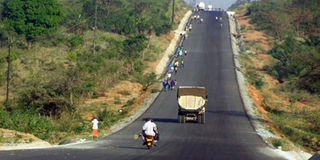Prime
Introduction to Hoima District

Road works on Hoima-Kaiso-Tonya road. The World Bank had frozen funding to the project, among others. PHOTO BY FRANCIS MUGERWA
What you need to know:
This week, in a four part series, Herbert Zziwa, Isaac Imaka, Rachel Mabala and Abdulaziizi Tumusiime look at how oil exploration has affected Hoima District so far. Today’s story focuses on a description, history and structure of the district.
It takes you close to two and a half hours to drive on a well tarmacked road from Kampala to Hoima District. It is not a journey that you can associate with many attractive landscapes, but the mushrooming towns like Busunju, Rwamata and Kiboga among others, make the journey worth travelling. At least that is what I felt when we travelled to the district.
The most pleasant town to make a stopover at, however, is Rwamata, where most travellers stop to buy refreshments. Many vendors run to each car that makes a stopover with lots of edibles, like the tasty roasted nyama chama, gonja, and bananas among others.
From Rwamata, it took us another hour to access Hoima District through Kyankwanzi District. It’s a quiet town with many rising structures, especially on the main street and newly-constructed Butyaba road.
The hospitality business seems to be a lucrative one with hotels like Hoima Resort and Nsava Hotel among others, receiving many customers especially the foreign workers from the oil fields who travel back to Hoima every day from Kaisotonya to sleep in the hotels.
Agriculture and cattle keeping seem to be thriving in the district and here in the town market, crops like matooke, maize and cassava are common. It’s also not an unusual thing to find cattle roaming on the streets of the town. Fishing is also another alternative source of income for those living near Lake Albert.
A few hours later, we go to the main street to meet the Cultural minister of Bunyoro kingdom, Hajj Bruhani Kyakuhaire. The charming tall and dark skinned Munyoro asks for quick introduction and after identifying my origin, he teases me about how we the Baganda are too lazy to learn other people’s languages.
Finally we settle at Kolping Hotel along Butyaba road for more serious engagement about the history of Hoima town. It is an interesting story and here is what you need to know about his district that is fast rising because of the oil deposits in its backyard.
HISTORY OF THE TOWN
The 72-year-old cultural minister of Bunyoro kingdom, Hajji Bruhani Kyakuhaire tells me that Hoima town is one of the oldest towns in Uganda, having been established around 1899 as a colonial administrative town in Bunyoro kingdom. Originally the town was called Kahoora (meaning a place where people sold their crops).
“Hoima was derived from a small river along Butyaba road which was known to help locals cleanse their crops and themselves before coming into the trading centre (Kahoora). That process of cleaning themselves was called Hoimora,” Kyakuhaire narrates.
“When the British colonialists came, they would frequently find many people at the river and they could not pronounce the name Hoimora; instead they called it Hoima. After some time the name became common and it was accepted as a town and district name,” he adds.
At Independence, Hoima was an entity within Bunyoro kingdom but when Ugandan Kingdoms were abolished in 1967, Bunyoro became a district. In 1974, Bunyoro was divided into North Bunyoro and south Bunyoro with the former becoming Masindi District and the latter becoming Hoima District in 1980.
Culture and tradition
As it is in the heart of Bunyoro kingdom, Hoima is predominantly occupied by the Banyoro who pay allegiance to Omukama (king) Iguru Gafabusa. It is in the heart of this town that you find the Omukama’s palace that was established by Omukama Duhaga around 1906 who was the son of Omukama Kabalega. The palace sits on a radius of 1km.
Omukama is the centre of unity among the Banyoro who come together in over 92 clans including the Ababito, Abanyinda, Abasiita and Abayaga among others. It is common practice in Hoima Town for Banyoro to bow their heads whenever the Omukama’s motorcade passes by.
Apart from the palace, the Mparo tombs located 2km from Hoima town along Masindi road is another attractive sight and this is where Omukama Kabalega and Tito Gafabusa the father of the current Omukama Iguru Gafabusa, were buried. The tombs were previously the palace of Omukama Kabalega and they were surrounded by five hills on which Kabalega stationed his warriors.
A melting pot
Though the town is mostly occupied by the Banyoro, the discovery of oil has attracted a population explosion, with other tribes especially the Baganda, Banyankole and Lugbara, now settling in the district.
In 2010, the Uganda Bureau of Statistics (UBOS) estimated the population of Hoima District at 499,100 and in 2011 the population was estimated at 523,400.For Hoima town, UBOS estimated its population at 40,600 and at 42,600 in mid-2011, but the Deputy mayor of Hoima Ronald Basiima believes that the figures have so far risen up to over 106,000 in Hoima Municipality.
Education sector
This population surge is now affecting service delivery in some sectors like education. The district currently has a total of 180 primary schools with 151 government, and 16 private and 13 community schools. The district has a total of 29 secondary schools, 11 of which are government schools, 12 private and six community.
Health sector
The Gender Minister in Bunyoro Catharine Abwoli says the district health sector is constrained with only 14 health centre IIs, 14 health centre IIIs, one health centre IV and one regional referral hospital. If nothing is done about it, she says, the district is destined for tough times.




